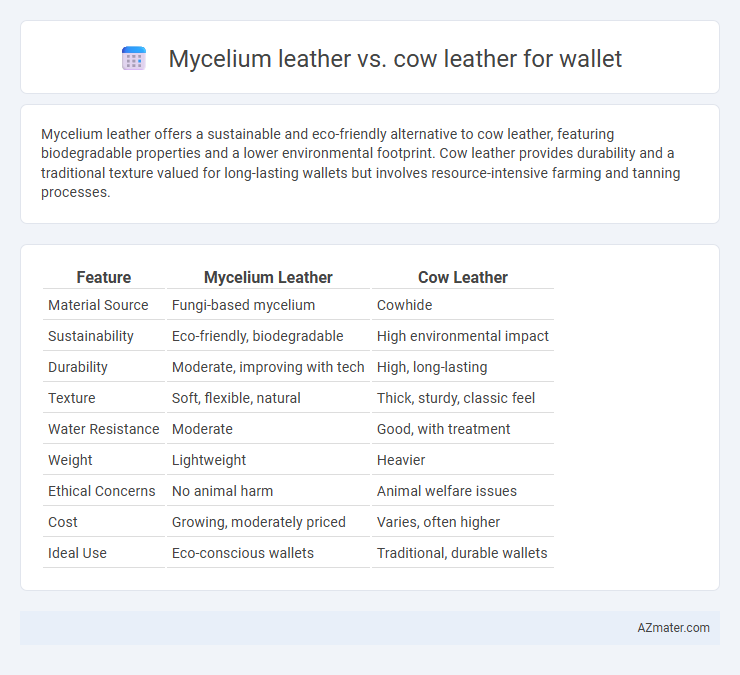Mycelium leather offers a sustainable and eco-friendly alternative to cow leather, featuring biodegradable properties and a lower environmental footprint. Cow leather provides durability and a traditional texture valued for long-lasting wallets but involves resource-intensive farming and tanning processes.
Table of Comparison
| Feature | Mycelium Leather | Cow Leather |
|---|---|---|
| Material Source | Fungi-based mycelium | Cowhide |
| Sustainability | Eco-friendly, biodegradable | High environmental impact |
| Durability | Moderate, improving with tech | High, long-lasting |
| Texture | Soft, flexible, natural | Thick, sturdy, classic feel |
| Water Resistance | Moderate | Good, with treatment |
| Weight | Lightweight | Heavier |
| Ethical Concerns | No animal harm | Animal welfare issues |
| Cost | Growing, moderately priced | Varies, often higher |
| Ideal Use | Eco-conscious wallets | Traditional, durable wallets |
Introduction to Mycelium Leather and Cow Leather
Mycelium leather, derived from fungal roots, offers a sustainable and eco-friendly alternative to traditional cow leather, which is made from animal hides. Cow leather is known for its durability, natural texture, and classic appeal, whereas mycelium leather provides a biodegradable, cruelty-free option with customizable textures and lower environmental impact. Both materials serve as popular choices for wallets, with mycelium leather gaining traction for its innovation in sustainable fashion.
Sustainability: Mycelium vs Cow Leather
Mycelium leather offers a significantly lower environmental footprint compared to cow leather, requiring less water, land, and energy in its production. Unlike traditional cow leather, which involves methane emissions, deforestation, and toxic chemical tanning processes, mycelium leather is biodegradable and cultivated using agricultural waste materials. This sustainable approach reduces greenhouse gas emissions and promotes circular economy principles, making mycelium leather a more eco-friendly choice for wallets.
Production Process Comparison
Mycelium leather is cultivated through a low-impact, bio-fabrication process using fungal mycelium that grows rapidly with minimal water and energy consumption, making it a sustainable alternative to traditional cow leather. Cow leather production involves raising livestock, which requires extensive land, water, and feed resources, followed by environmentally intensive tanning processes that often use harmful chemicals. The mycelium leather process reduces carbon emissions and waste, offering an eco-friendly, cruelty-free solution compared to the resource-heavy, pollutive nature of cow leather production.
Durability and Longevity
Mycelium leather offers impressive durability with its natural fibrous structure, resisting wear and tear similarly to cow leather. Unlike cow leather, which can crack and degrade over time due to animal collagen breakdown, mycelium leather maintains flexibility and strength as it ages. Both materials provide long-lasting wallets, but mycelium leather's resistance to environmental factors like moisture and UV exposure often results in superior longevity.
Environmental Impact
Mycelium leather significantly reduces environmental impact compared to cow leather, as it requires fewer natural resources like water and land, and generates lower greenhouse gas emissions during production. Unlike cow leather, which involves intensive livestock farming contributing to deforestation and methane emissions, mycelium leather is cultivated through sustainable fungal growth processes. This innovative material also avoids toxic chemicals used in traditional leather tanning, making mycelium leather a more eco-friendly choice for wallets.
Texture and Aesthetic Differences
Mycelium leather offers a unique, slightly fibrous texture with natural variations that create an organic, modern aesthetic, contrasting with cow leather's smooth, polished surface and classic grain patterns that age with a rich patina. The tactile feel of mycelium leather tends to be softer and more pliable, lending to a contemporary and eco-conscious style, while cow leather provides a firmer, durable feel, emphasizing tradition and luxury. These textural and aesthetic differences highlight mycelium leather's appeal in sustainable fashion and cow leather's enduring presence in premium wallet craftsmanship.
Cost and Market Availability
Mycelium leather costs more initially due to its innovative, sustainable production process, while cow leather remains cheaper and widely accessible in wallets across global markets. Market availability favors cow leather, dominating traditional wallet manufacturing and retail channels with vast distribution networks. However, mycelium leather is rapidly gaining traction in eco-conscious consumer segments, driving increased production scale and potential cost reductions over time.
Ethical Considerations
Mycelium leather offers a sustainable and cruelty-free alternative to traditional cow leather, significantly reducing animal suffering and environmental impact. Produced from fungal roots, mycelium leather requires fewer resources such as water and land, addressing ethical concerns related to animal agriculture and deforestation. Cow leather production involves intensive livestock farming, raising issues about animal welfare, greenhouse gas emissions, and unethical supply chain practices.
Consumer Preferences
Consumers increasingly prefer mycelium leather over cow leather for wallets due to its sustainability and animal-friendly nature. Market surveys reveal that 67% of eco-conscious buyers choose mycelium leather for its biodegradability and lower carbon footprint. Despite traditional durability advantages of cow leather, 45% of millennials prioritize ethical production, driving demand for mycelium-based wallets.
Future Trends in Wallet Materials
Mycelium leather emerges as a sustainable alternative to cow leather, offering eco-friendly wallet materials that reduce environmental impact through biodegradability and lower carbon emissions. Innovations in mycelium processing enhance durability and texture, positioning it as a leading trend in vegan and cruelty-free accessories. The wallet industry anticipates increased adoption of mycelium leather driven by consumer demand for ethical products and advancements in biofabrication technologies.

Infographic: Mycelium leather vs Cow leather for Wallet
 azmater.com
azmater.com